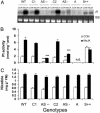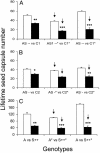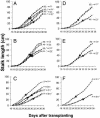Constitutive and inducible trypsin proteinase inhibitor production incurs large fitness costs in Nicotiana attenuata
- PMID: 14757829
- PMCID: PMC341788
- DOI: 10.1073/pnas.0305096101
Constitutive and inducible trypsin proteinase inhibitor production incurs large fitness costs in Nicotiana attenuata
Abstract
Plant trypsin proteinase inhibitors (TPIs) are potent herbivore- and jasmonate (JA)-induced defenses, but support for the commonly invoked explanation for their inducible expression, namely their associated fitness costs, has been elusive. To determine whether the expression of TPIs incurs fitness costs, we expressed 175 bp of the seven-domain pi from Nicotiana attenuata in an antisense orientation in a TPI-producing genotype (WT) of N. attenuata to reduce TPI expression. Moreover, we expressed the full-length seven-domain pi in a sense orientation under control of a constitutive promoter to restore TPI activity in a natural genotype unable to produce TPIs because of a mutation in its endogenous pi gene. Lifetime reproductive output was determined from high and low TPI-producing plants of the same genetic background with and without JA elicitation and grown in the same pot to simulate natural competitive and nutrient regimes. Transformants with either low or no TPI activity grew faster and taller, flowered earlier, and produced more seed capsules (25-53%) than did neighboring TPI-producing genotypes, and JA elicitation increased TPI production and decreased seed capsule production further. Growth under high light levels only marginally reduced these fitness costs. Results were similar regardless of whether TPI activity was suppressed or restored by transformation: the larger the difference in TPI activity between neighbors, the larger the difference in seed capsule production (R(2) = 0.57). TPI production is costly for a plant's components of fitness when grown under realistic competitive regimes and is consistent with the hypothesis that inducibility evolved as a cost-saving mechanism.
Figures




References
-
- Strauss, S. Y., Rudgers, J. A., Lau, J. A. & Irwin, R. E. (2002) Trends Ecol. Evol. 17, 278-285.
-
- Cipollini, D. F., Purrington, C. B. & Bergelson, J. (2003) Basic Appl. Ecol. 4, 79-85.
-
- Hare, D. J., Elle, E. & van Dam, N. M. (2003) Evolution 57, 793-805. - PubMed
-
- Feeny, P. P. (1976) Recent Adv. Phytochem. 10, 1-40.
Publication types
MeSH terms
Substances
Associated data
- Actions
- Actions
LinkOut - more resources
Full Text Sources
Other Literature Sources
Research Materials
Miscellaneous

